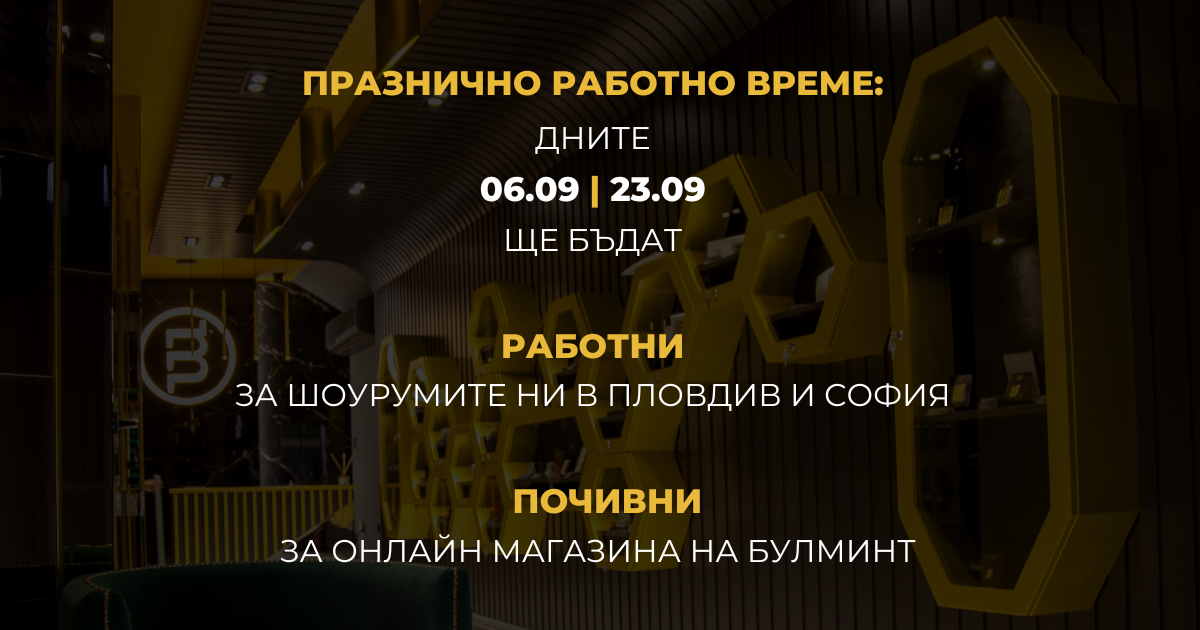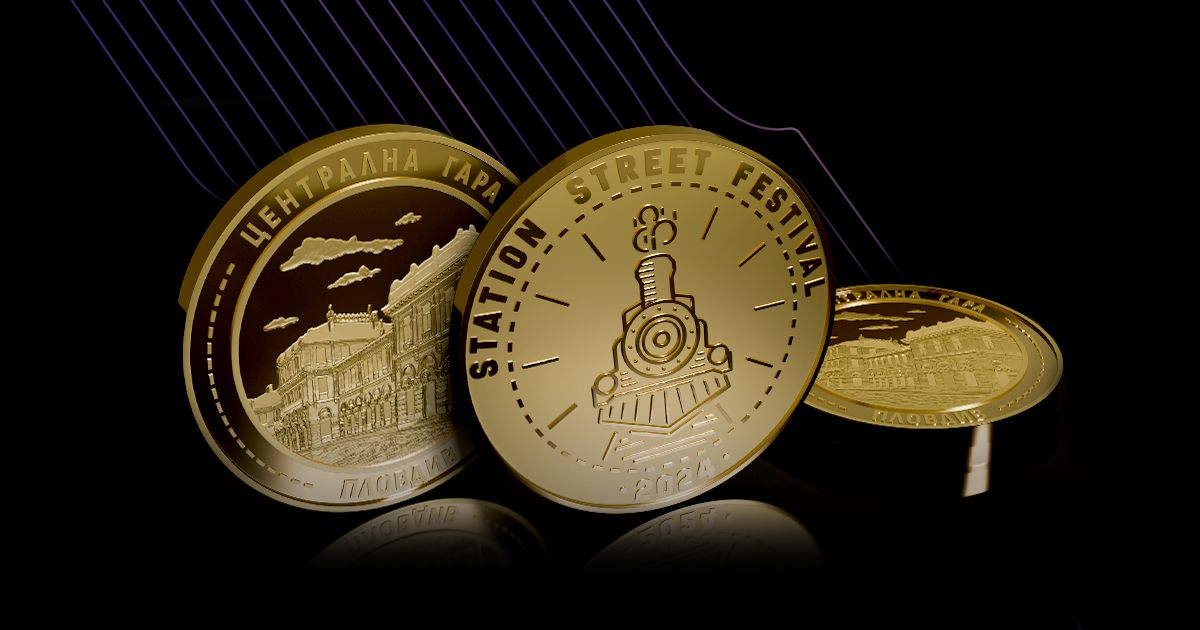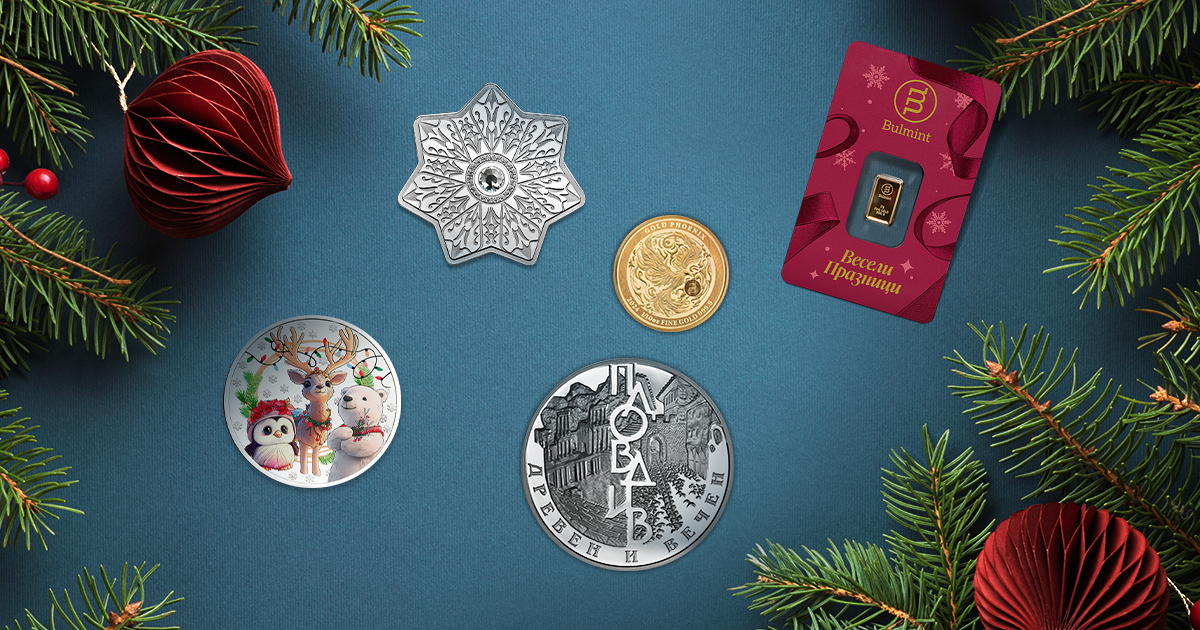
Christmas holiday traditions in Bulgaria – from folklore, Christianity, and pop culture
Published on 12 December 2023
Bulgaria’s folk traditions are a colourful blend of Christian and Pre-Christian customs.
The Christmas holidays are especially rich in symbolism. The complex rituals performed throughout the winter season aim to protect and cleanse the community and to invite abundance and prosperity throughout the upcoming year.
The Bulgarian Customs and Traditions program is inspired by the folk practices that have preserved our cultural identity through the centuries. Each precious metal art medal in our portfolio of collectible products is imbued with symbolism – let us delve into the traditions these holiday-inspired pieces celebrate.
Folk Traditions Surrounding Christmas Eve and Christmas
The days between December 24 and January 6 are considered dark and dangerous – a transitional period between the old and the new yearly cycle. According to Bulgarian beliefs, during this time, the newborn sun is still weak and evil freely roams the earth. The rituals performed in relation to the holidays are meant to bring protection to the community and to help the world cleanse itself. To this very day, the many of the Christmas Eve traditions are practiced even in the most urbanised parts of Bulgaria.
Koleduvane
This ritual takes place from Christmas Eve to December 27. It is performed by carolers known as koledari - a group of young unmarried men led by a single married man known as a stanenik.
Preparation begins on December 20 – the group gathers at the stanenik’s house and, over the course of several days, studies a repertoire of about 50 lyrical texts sung to several melodies. The carols are strictly ritualistic and can only be performed at this time of year.
For three nights, starting from Christmas Eve, the group goes around the village, singing the carols in every home, blessing the household and bringing health and prosperity. Each song has its own function – some of them are meant to be sung along the way, others in front of the gates, and the last group are performed inside the house. There is a separate song for each member of the family. The lyrics combine Christian with mythical and folk elements – their magic lies in the power of the spoken word. The carols describe scenes of abundance and happiness as if they have already happened, hoping to transform these words into reality. It is believed that by entering a home, the carolers bring luck and fortune upon it, and their songs have the power to drive out evil. In exchange, the household presents them with coins and gifts.
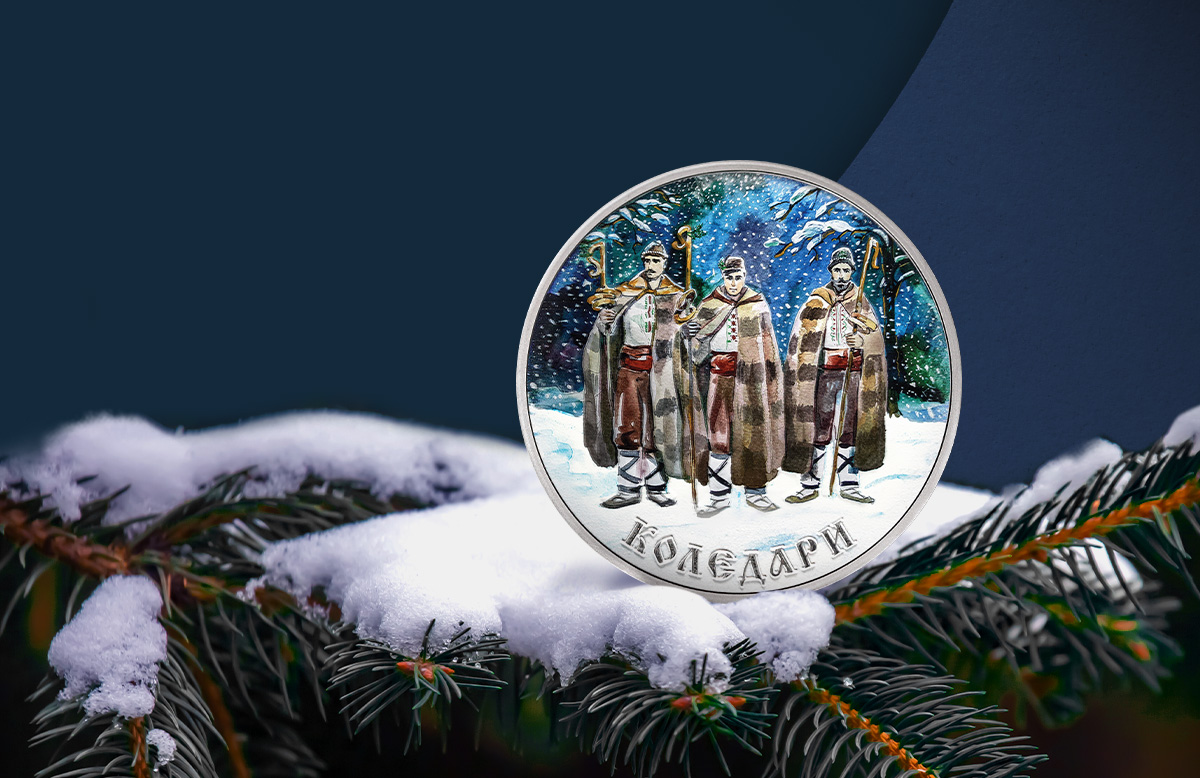
The iconic image of the caroller with ring-shaped pastries looped through their shepherd’s crooks is deeply ingrained into our culture. This is the picture we chose to recreate on the obverse of the Koledari silver medal, and the detail of the motif is further enhanced through digital colorisation made to look like a watercolour illustration. Three carollers are depicted, clad in traditional clothing, with festive wreaths around their hats and baked goods looped through their shepherd’s crooks.
The ritual can only be performed at night. The group sets off from their leader’s house and walks around the whole village or a predetermined neighbourhood until dawn, so that the sun does not catch them outside.
The koleduvane type of caroling carries warrior elements, and acts as a rite of passage for the participants – afterwards they gain the right to marry.
Baking a coin into the Christmas Eve bread
Nowadays, on Christmas Eve we celebrate the Nativity of Christ, but the roots of the holiday lie in the much more ancient belief in the young sun deity known as the Young God or even Pale God. According to the tales of old, on this evening, we can foretell and even influence the upcoming year.
The holiday dinner table is the epicentre of the Christmas Eve customs. It needs to be abundant, so that the following year would too be abundant. The dishes must be vegetarian due to the fact that this is the last day of the Christmas fast, and a mandatory fixture are foods that “swell” - beans, rice, bulgur, and wheat. They are often an uneven number – 7 or 9, which are attributed magical properties – because in our people’s minds even numbers represent completion and therefore death. The dishes can also be 12 – like the months of the year.
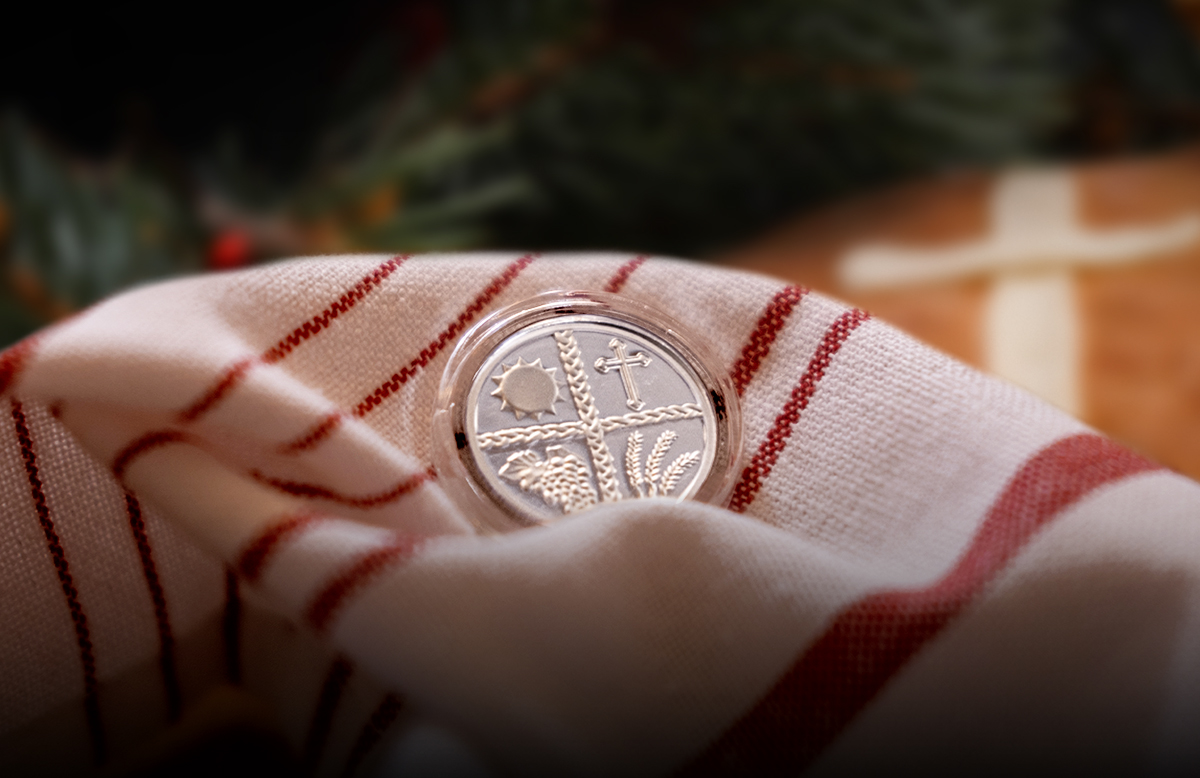
The centrepiece is the ritual bread, called a "bogovica" or "badnyak" - a vegan bread whose round shape also references the sun and the cyclical nature of the yearly calendar. It is decorated with shapes made of dough, such as the Christian cross, wheat, the sun, grapes and more. Key to this ritual is the practice of baking a silver coin into the bread, which acts as a means of predicting the future. When the bread is broken, each member of the family receives a piece, and a few are symbolically set aside for the Virgin Mary, the deceased members of the family, the estate, and the livestock. The belief holds that whoever gets the piece with the coin inside will get the lion’s share of good luck throughout the upcoming year. The silver itself has its own symbolic meaning – a number of cultures, including ours, prescribe it the ability to bring luck and fortune upon its bearer.
The table remains set overnight so that the saints and the deceased may also partake in the festivities.
In honour of this beautiful custom, we created the Silver Medal for the Christmas Eve Bread. The traditional bread decorations now shine in proof matt-gloss quality on the obverse, while the reverse happily proclaims “Happy Holidays” in Bulgarian. This silver medal revives a purer version of the ritual in your home while remaining a precious keepsake from the holiday through the years.
Smoke cleansing with frankincense
One of the most important ritualistic practices associated with Christmas Eve is the act of cleansing the home with frankincense smoke, performed to drive out all evil. It starts from the dinner table and moves onto every room and all other structures that are property of the household. Once the cleansing is complete, the family can begin the new year with a clean slate.
The role of trees in the tradition
In Bulgarian folk tradition, the tree around which the family gathers is not the richly ornamented Christmas tree, but the so-called badnik – the trunk of a straight tree around three years in age. Most often it comes from an oak tree, but it may also be from a pear tree.
The badnik must be cut down by a young bachelor or newlywed. Early in the morning before Christmas Eve, he must find a suitable tree, cut it down, trim it, and take it home.
The badnik is then sanctified – at its base, the members of the household carve a small hole and fill it with cow’s butter and olive oil, frankincense and wax, and then plug up the hole with a wooden peg. The lower edge of the trunk is then wrapped in linen. In the evening, it is placed inside the fireplace, where it burns until morning. The coals may only be put out with wine, and the ashes are set aside and kept for later use in fertility and healing rites.
Christian traditions
December 24 is the Eve of one of the most significant and joyous Christian feasts – the Nativity of Christ. The canonical scriptures do not specify when the Saviour was born, and the church officially declared December 25 to be the day of the Nativity in the 4th century – possibly to Christianise the existing festivals surrounding the winter solstice. Before that, the feast day of Epiphany was a celebration of all of Jesus’ appearances – his corporeal birth, as well as his spiritual birth through his baptism.
Once Christianity became the dominant religion in Bulgaria, the image of the Young God was replaced with that of the Infant Jesus.
The Nativity scene in icons and Scripture
The Biblical tale takes us to Bethlehem – Saint Joseph the Bethrothed’s hometown, where he was called to return for a census by the decree of Caesar Augustus. Despite her heavy pregnancy, the Virgin Mary accompanied him on his journey – his wife in name only, whom he was charged with protecting. But all the inns in the small town were full, and the two were forced to seek shelter in a cave on the outskirts, where the local herdsmen would leave their livestock overnight. In these humble conditions, the Saviour of humanity was born. Angels of the Lord spread the news far and wide as a beam of light from the miraculous Star of Bethlehem guided three wise men from far-away lands towards Christ so that they may pledge themselves to him and offer him gifts.
There are two main ways Orthodox iconography depicts the scene.
The first type emphasises Jesus’s human nature – and the sacrifice he made when he lowered himself to being born as a man. In this type of icon, the Mother of God is depicted lying down, tired from her labour. Her figure is the largest in the composition, which serves as a visual indication of her importance. Saint Joseph is depicted separately, outside the cave, tormented by doubt, and next to him the Devil in the guise of a shepherd tempts him. These icons usually include additional characters – angels who are announcing the birth of Christ to shepherds, and the three magi from the East. Sometimes two women are depicted in a corner of the composition, bathing a second figure of the Infant Jesus.
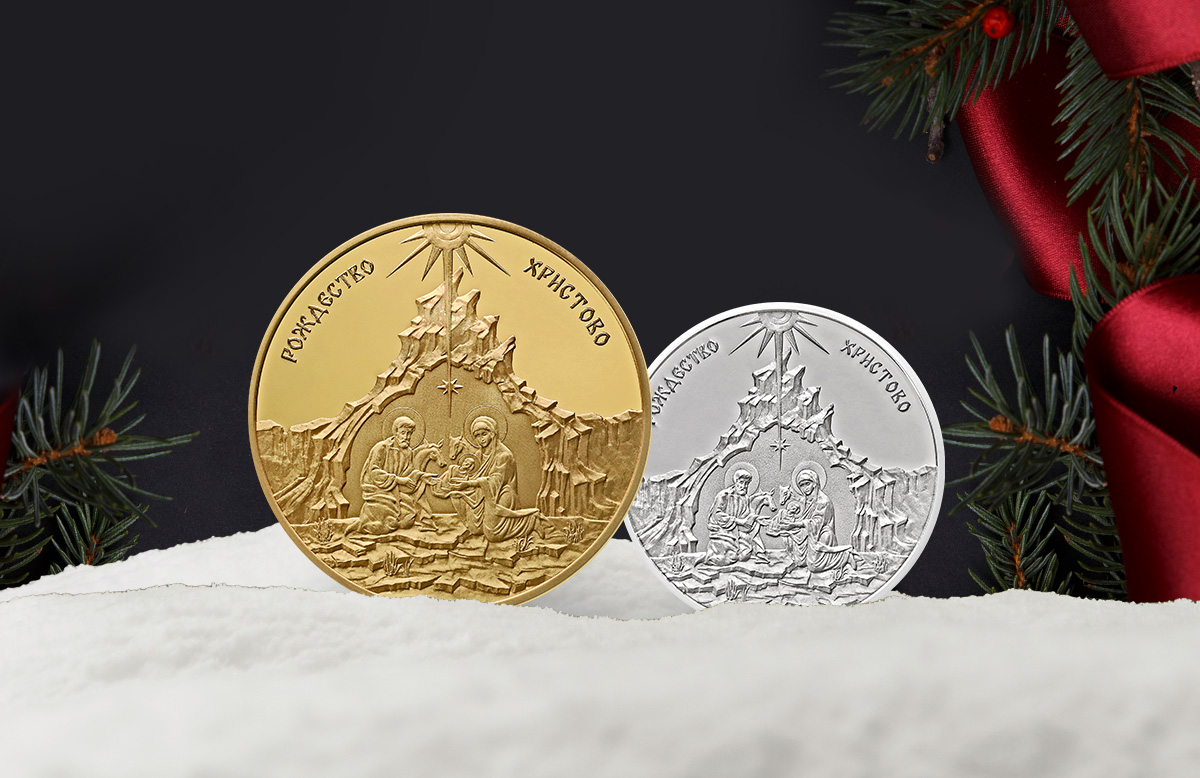
It is the second type of Nativity icon that inspired the Nativity of Christ silver and gold-plated copper medals – here the emphasis is on his divine nature. Here Jesus is in the centre of the composition - the white swaddling cloths he is wrapped in and his halo seem to shine against the cave interior – a symbol of the sinful world whose darkness can only be dispersed by the light of the Messiah. Despite the symmetry of the composition, the Holy Mother of God in the foreground – a place of honour reserved for the mother of the renewed human lineage. She is on her knees so soon after the miraculous birth through which she ensured the salvation of humanity. This is a reference to one of the central doctrines related to the Nativity – while Bulgarian folk songs tell us that her labour began on the feast of Saint Ignatius, Orthodox Christianity teaches us that she gave birth painlessly. Saint Joseph, who is the protector of the Mother of God, but not Jesus’s father – is ever-so-slightly in the foreground, with hands reaching out towards the Infant Christ in reverence. The ox and the donkey behind the holy family carry a secret message. Their breath is what warmed Jesus throughout the cold night in the cave, but their status as a near-universal fixture in the Nativity icons are a reference to the scripture “The ox knows its master, the donkey its owner's manger, but Israel does not know (Me), My people do not understand.” (Isaiah 1:3). This detail beckons us to understand and get to know God. Above the cave and around it are the figures of angels, herdsmen, and, in the distance – the three magi.
The Fast in Preparation for Nativity
The purpose of this fast is to cleanse so that one may welcome the Nativity of Christ with a pure heart, soul, and body. It starts on November 15 and continues until Christmas Eve.
In the first week of the Nativity fast and on the days from December 20 to December 24, one may only eat plant-based foods with oil. On the rest of the fast days, fish is also allowed. On Christmas Day the fast must be broken even if it falls on a Wednesday or a Friday – traditional fast days regardless of the time of year.
The physical aspects of the practice are only part of the preparation for the Nativity. Equally important are the spiritual aspects. One must not only abstain from certain types of food, but also from superficial and impure thoughts, from sin and all evil.
A fast is only considered spiritually cleansing if the required diet is accompanied by prayer and repentance, abstinence from bad deeds, forgiveness towards those who have wrong us, and abstinence from physical intimacy and entertainment.
Secular Christmas traditions and legends
Under Western and even Russian influence, in the 20th century Bulgaria adopts new holiday traditions and symbols. Many of them appeared at a late stage of human history and bear no connection to Biblical canon. This combination of foreign folk elements and pop culture does not carry the same gravity as the folk and Orthodox practices, which makes these holidays particularly appealing to children.
Santa Claus
The image of the Jolly Old Man is based on Saint Nicholas the Wonderworker – the bishop of the city of Myra sometime around the 3rd century, in the region of Lycia. The most famous legend about him tells us about the time he secretly came to the aid of a father who had fallen on rough times and had decided to sell his three daughters’ honour. Several times the saint threw a bag full of gold through the man’s window – a dowry for each of the maidens, so that their father could marry them off and save them from the cruel fate. This story is also the basis of Santa Claus’s role as a kind-hearted old man who secretly brings gifts to children.
Saint Nicholas is held in very high regard in Europe across the centuries even after the Reformation that discouraged the veneration of saints in Protestant countries.
The Dutch brought his cult overseas to the United States in the 18th century. Over the years the character gradually entered various aspects of pop culture and even political propaganda. He acquires some of the traits associated with the mythical Father Christmas and loses Saint Nicholas’s bishop’s garb, but for a long time, there is no unified idea of what he looks like. His role in the holiday – to bring gifts to children under the cover of night, – as well as his magic sleigh pulled by flying rein-deer, is made famous by Clement Clarke Moore’s "A Visit from St. Nicholas".
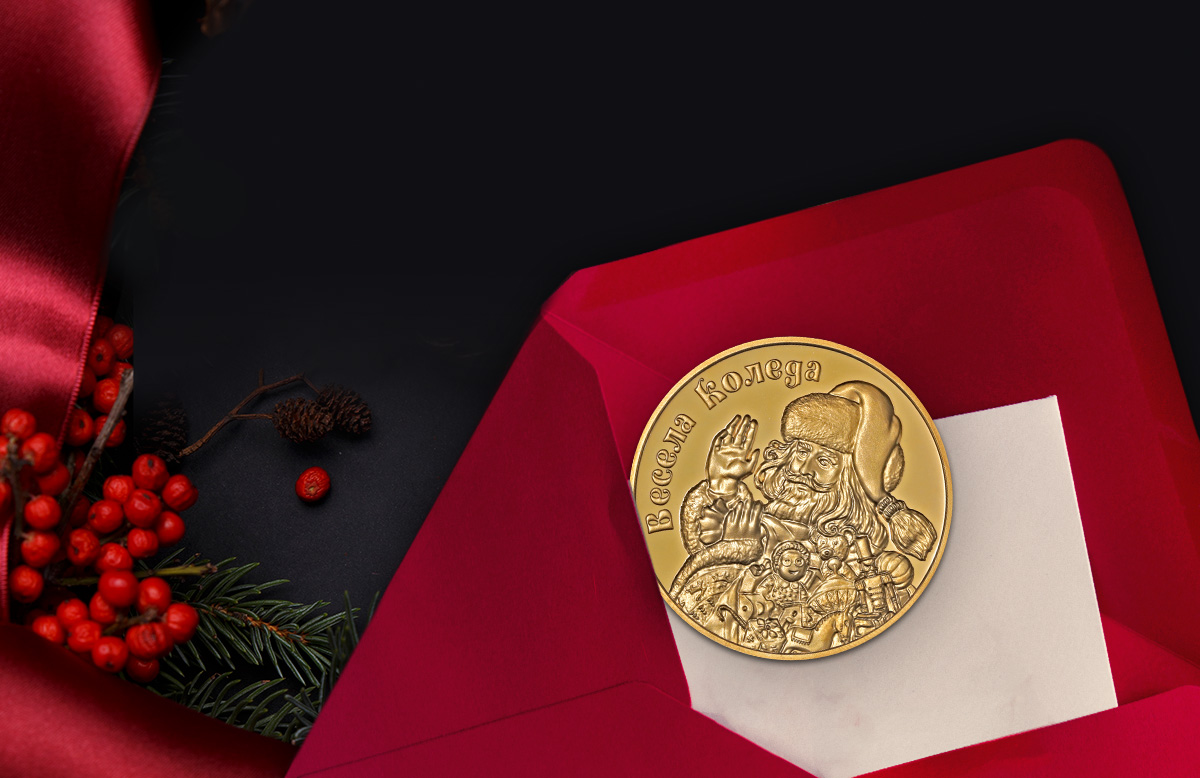
The modern idea of Santa Claus is associated with a series of extremely influential Coca Cola ads from the 1920s and 30s. They are based on the plethora of illustrations of the Jolly Old Man up to that point and even evolves throughout the course of the company’s advertising activity. In 1931, Haddon Sundblom’s version debuts – and so the picture of the smiling bearded old man with red clothes and black boots starts spreading worldwide. Different European cultures blend the legendary character with personifications of the winter season from their own folklore, such as the English Father Christmas and the Slavic Ded Moroz.
Today Santa Claus is the embodiment of everything that makes this holiday so festive. This is what inspired us to create the Santa Claus Christmas Medal – meant as a gift for the young and the young at heart that captures the magic and forever preserves the excitement born of this enchanting time of year.
Christmas trees
Trees play a significant role in a number of mythologies. The ancient Celts attributed special magical properties to every tree that grew in their territory, and the idea that the universe is supported by a Cosmic Tree exists in a number of cultures all over the world. They have been in use in religious rites since ancient times, but according to some sources, the custom of decorating Christmas trees originates in Germany.
During the Middle Ages, German holiday traditions begin to incorporate evergreen trees with apples hung from their branches – a reference to the Tree of Knowledge from the tale of Adam and Eve. The symbolism of these trees also plays into the holiday – they represent eternal life.
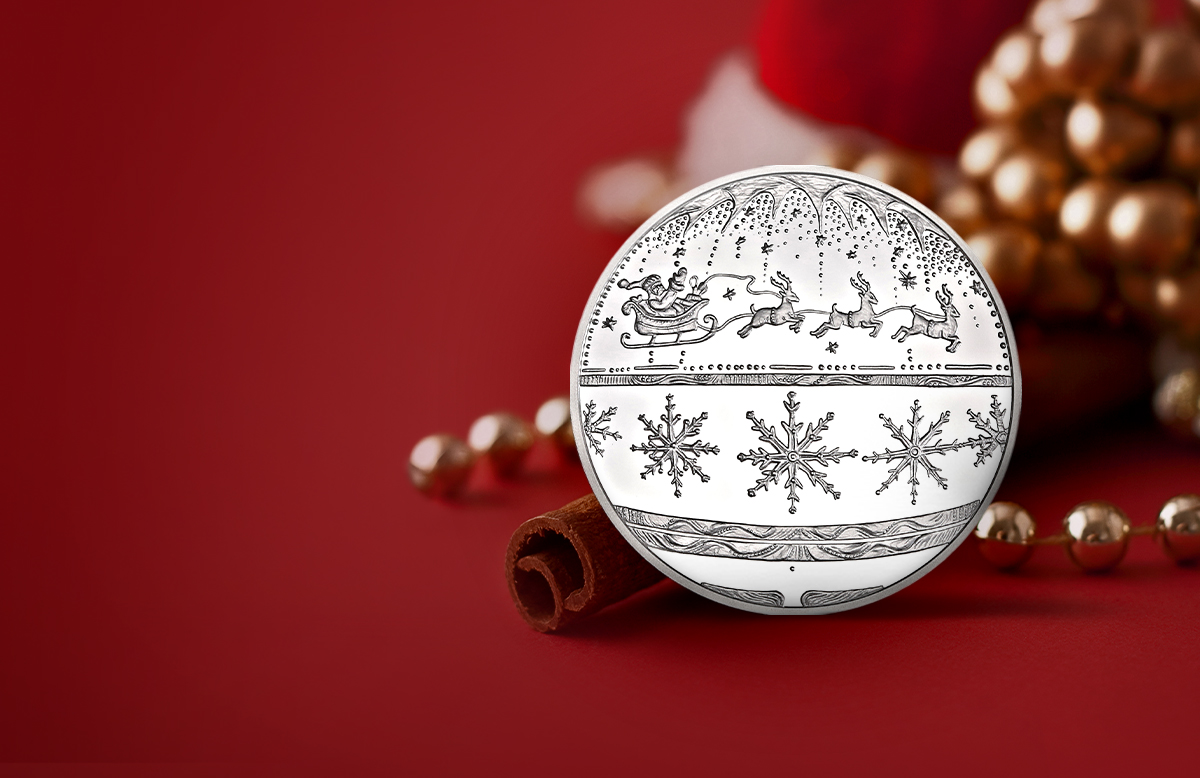
The tradition gradually changed – it began to incorporate other decorations, and German migrants spread it to other countries. It gained popularity in Great Britain when in 1848 a London newspaper published an illustration of the royal family gathered around a decorated tree. Once again, it was German immigrants who spread the tradition to the US despite the local puritans’ objections.
The tradition gradually spread to other parts of the world, and Bulgaria adopted it after the Liberation under Russian influence.
The custom of decorating evergreens with beautiful baubles is reflected in the Happy Holidays Silver Medal. One of our most interesting art pieces combines deep relief with perspective in the design to create the 3D feel of a spherical ornament.
Exchanging gifts
Christianity draws a parallel between the custom of exchanging Christmas gifts and the Biblical story of The Adoration of the Magi. It speaks of three wise kings from the east who travel thousands of kilometres to pay their respects to the Infant Jesus.
The Old Testament prophets foretell that 490 years after the reconstruction of the Temple of Jerusalem, in the town of Bethlehem – the birthplace of King David – the Messiah will be born of a virgin. Guided by these prophecies and by the light of the miraculous Star of Bethlehem, they appear before Christ and present him with gifts fit for a king – gold, frankincense, and myrrh. Here it is important to note that frankincense is used in religious ceremonies, and myrrh essential oil is used in funeral rites. The most common interpretation is that these offerings are an allegory for different aspects of the incarnated God’s life on earth – gold represents his rulership, frankincense symbolises his role of spiritual leader, and myrrh symbolises the sacrifice through which he would absolve humanity of its sins.
The link between Christmas and Santa Claus – despite the fact that Saint Nicholas’s feast day is on December 5, December 6, or December 19 – increases the ode to charity this holiday represents.
This tradition, however, exists in other religions as well and predates Christianity. It was part of the celebration of Saturnalia, an Ancient Roman winter solstice festival. Most likely, during the festival’s assimilation into Christianity, some of its elements from the original pagan festival remained.
Over the centuries this custom underwent change, and many countries gave it their own twist. An interesting example is the effect of modernisation on the mythical gnomes called nisse from Scandinavian folklore.
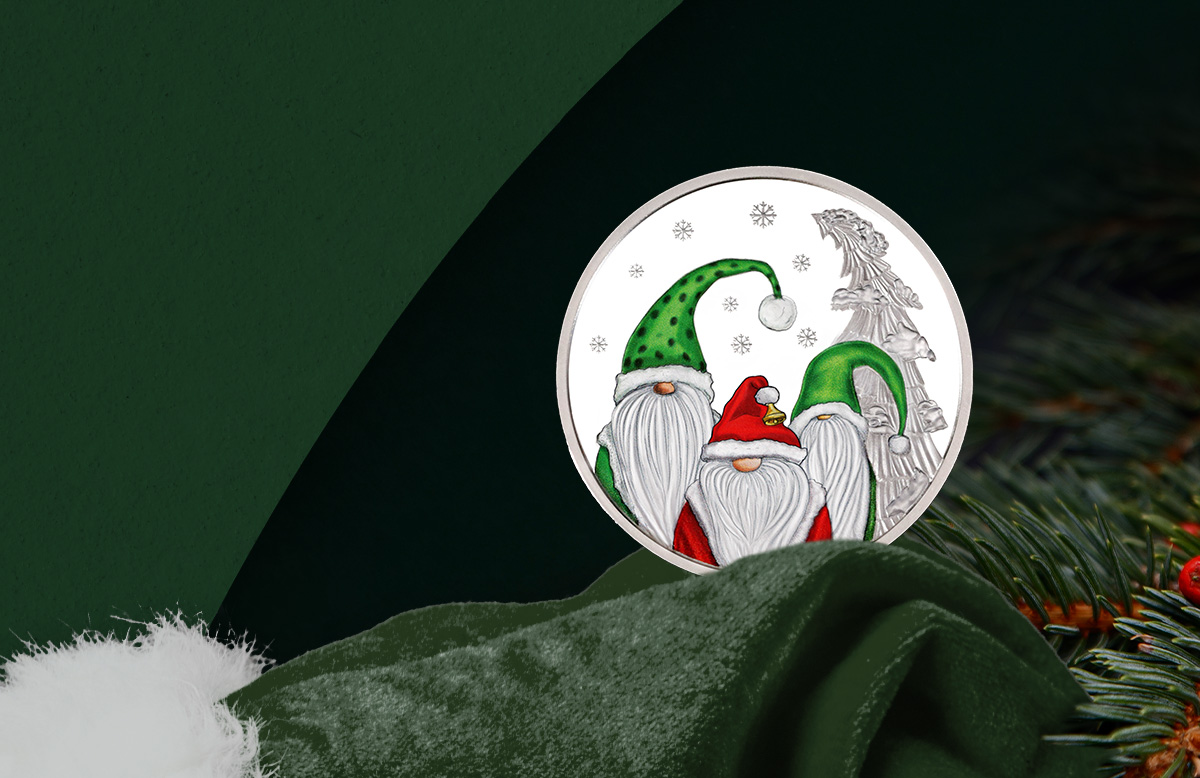
These small, bearded household spirits with cone-shaped hats and a mischievous air are secret protectors of the home, family, and especially children. But modern life has given them a whole new facet. Nowadays they are associated with the Christmas traditions and, much like Santa Clause, are believed to bring gifts and wonders to children – a characteristic absent from the original idea of them. We recreated this new interpretation of the gnomes in the Christmas Fairytale Silver Medal – a gift meant especially for children. This modern twist to the legend is reflected in the choice of colours for the digital print on the obverse – red and green, which today are considered among the symbols of the holiday.
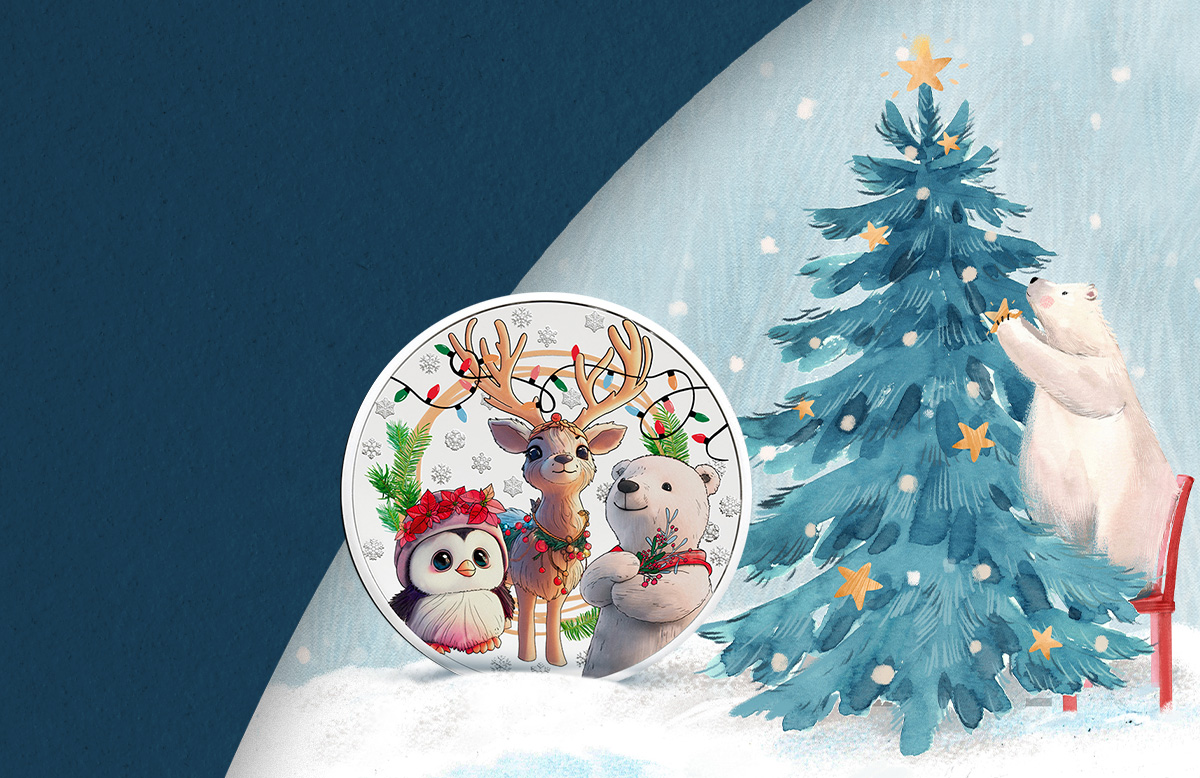
There is a class of gifts that bear a strong significance in Bulgarian culture. Our forebears attributed magical properties to them, such as the power to protect, connect the mortal world to the divine, and to help during transitional periods. The unfading and intrinsic value of gold and silver have turned them into a symbol of wealth and high social standing – and some believe that owning them attracts abundance. They are traditionally gifted in honour of the most significant moments in life – the birth of a child, baptisms, and weddings, but they are a classic and sophisticated choice regardless of the occasion. It is this custom that inspired the My First Christmas silver medal, meant to be given as a gift to a newborn.
The spirit of Christmas today
All these characteristics – the beauty of Bulgarian tradition, Christian beliefs and values, and the modern holiday atmosphere – transform the days surrounding Christmas into the most exciting time of the year for many. Filled with hope and carrying a message of charity and love, they bring joy to people of all walks of life.
The Bulgarian Customs and Traditions program celebrates the traditions that have kept our people’s spirit alive through the centuries – and urges every Bulgarian to preserve these treasures for their children. And select silver medals with artistic value transform the wonderful memories of time spent with our nearest and dearest into a keepsake of pure precious metal. Browse Bulmint’s collectible product portfolio here.

